
When outsiders visit Cuba for the first time, they’re struck by how much of the country is seemingly frozen in time — 1958, to be exact, the height of the Cuban Revolution. For our John Moist, a visit was an occasion to tour the historic ballparks of Cuba — which seem to be frozen in time as well. Here’s his story.
In January 2010 and again in 2011, I was fortunate to be part of a baseball tour of Cuba, conducted by a Canadian group, Cubaballtours, which has offered these tours since 2001. In the course of the tours we attended eleven games in western, central and eastern Cuba, and met several players, former players and team and league officials. We also got a chance to spend a lot of time in Havana and Santiago, saw much of the countryside and other cities, and learned a little about life in Cuba.
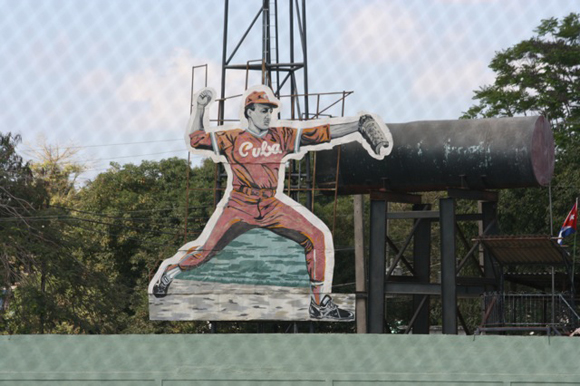
Tour participants were encouraged to bring donations, such as baseball cards, balls, bats, gloves, hats and other equipment. We gave these to kids at ballparks and several schools. I brought a dozen new baseballs and 24 unused souvenir caps that I had been hoarding for years. One boy, about 6, now has a new Phillies hat that I got at the Vet in 1997. It’s way too big for him, and when he turned his head, the cap started spinning, but he would not let go of it.
Cuba Today
We had a chance to hear about life in Cuba, and the benefits and downside of the Cuban communist government. The country has a very high literacy rate, since everyone must attend school through ninth grade, then choose between school and technical training through 12th grade. There are many universities in Cuba, but with the end of the communist bloc, there are few opportunities for highly trained people, including doctors, and it is very difficult to leave the country. As a result, people trained in nuclear physics are working at hotels.
Until a few years ago, the economy was run by the state, and there were virtually no businesses in Cuba. Tours for foreign visitors are now common, and individuals can now start their own business, such as a restaurant or car repair shop, but they cannot expand and start a company. The country wants to bring in more money, and there is talk about the “Chinese model” to allow capitalism and franchise restaurants (like Burger King) licensed by the government, but Raul Castro and other leaders are apparently against that. Fidel is now fully retired, but sometimes shows up on TV at public events. The remaining leaders are still people in their 70s or 80s, despite efforts to bring in younger leaders. Starting in 2011, people are being encouraged to start small businesses, and the government is reducing benefits to encourage this.
There is very little violent crime in Cuba. We were encouraged to walk around Havana at night and encountered no problems of any kind, and found everyone we met to be friendly. Tourism is being expanded and some classic locations, like the Hotel Parque Centrale and Hotel Nacionale (have been restored to their original luxury. The neighborhood around the Hotel Nacionale offers several restaurants, bars and clubs featuring great Cuban jazz. Baseball fans will be glad to know that there are two very good beers brewed in Cuba, Bucanero and Crystal, and there is a brew pub in Havana’s Playa Vieja. And, of course, the government also produces the classic Havana Club Rum.
One of the first things visitors notice: many of the cars on the streets are classic American cars, up to the 1958 models. There are also some old Russian cars and some newer Chinese cars, but none from the United States or Japan. Many of the American cars are taxis, like the ’57 DeSoto we rode in. (We should have held out for one of the many classic Chevies, Buicks and Fords!)
Most of the cities and towns are in a state of decay, with literally no recently painted buildings anywhere except in central Havana and Cienfuegos. Many people own their homes, but several generations live in each house, and it’s very difficult to move. Reforms are currently underway to loosen the ability of citizens to sell homes and cars, and we saw some painting and repairs to the historic part of Havana on our 2011 visit.
Baseball in Cuba
As you probably know, baseball is the national sport of Cuba. It’s played by kids in schools and in the streets. We saw a game played inside the cloverleaf of the on-ramp to a major highway in Havana — no backstop or fences, just a field with foot-worn base paths, and we wondered how these kids would retrieve a ball hit out to the highway.
Cubans love to talk baseball. The Esquina Caliente, or Hot Corner of Havana’s Parque Central, is where many fans, old timers, younger kids (and baseball tourists) meet every day to talk baseball.
A highlight of the tour was a visit to Cruces, the hometown of Martin Dihigo, considered to be Cuba’s greatest player. We met Dihigo’s son, a former farmhand for Cincinnati and teammate of Tony Perez and Pete Rose, and visited Martin’s gravesite. Martin Dihigo (1905-71) played from 1922 to 1950 in the Negro, Cuban and Mexican Leagues as a pitcher and a fielder, playing most positions, and is thought to have had one of the best throwing arms of any player in history. He is a member of the Baseball Hall of Fame (1977), Cuban Baseball Hall of Fame (1951) and the Mexican Baseball Hall of Fame. The only other Cuban-born members of the National Baseball Hall of Fame are Tony Perez and early 20th-century pitcher Jose Mendes.

We also visited Conrado Marrero, at 100 the oldest living former major league player, in his home in Havana. Marrero pitched for the Washington Senators from 1950-54 and was selected to the American League All-Star Team in 1951.
The Ballparks and Teams of Cuba
The Cuban National League currently consists of seventeen teams, divided into four divisions. Ballpark sizes range from 10,000 capacity to 55,000.
The range of food and facilities varies a lot from park to park. One park we visited had many vendors inside and out as well as several restrooms, but many parks have no food or drinks of any kind. However, it seems we saw more ballpark food and concessions on our second visit in 2011 than we did in 2010.
Teams sometimes play in alternate parks, some very small and in rural areas, in order to reach more remote fans, and games are often shifted to different parks with little advance notice. (Orlando “El Duque” Hernandez once pitched in a game played at Havana’s Psychiatric Hospital.) Many players do not like to play in rural parks because there are fewer fans and the parks may be in poor and unsafe condition. The number of parks in the National Series the season has been reduced from over 100 to less than 40 for 17 teams.
However, there is no denying that attending baseball games in Cuba is lots of fun, and the Cuban fans are knowledgeable, informed and are watching the game intently the entire time. Every game we attended had a wide variety of kids, teenagers, families, and older men. It was all about the baseball game. A few men would be smoking cigars (many of them visiting tourists), but overall we saw very little smoking of cigars or cigarettes anywhere in Cuba, including at the ballparks.
What food that was available in the parks was likely a ham sandwich, fruit or peanuts served in a small funnel. We never saw any sodas or other drinks, and no beer or other alcohol is sold at Cuban ballparks. Of the eight parks we visited, only Estadio Latinoamericano had a small booth selling caps, shirts and a few other items. Fans dressed moderately, with very few wearing team gear. At least one game is televised nationally every night, but most are now day games, in order to save electricity.
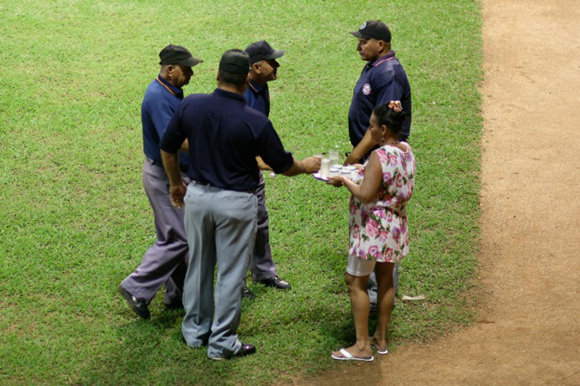
There are a few aspects of Cuban baseball that are different from American ball:
- Whenever a run scores, the entire team lines up on the field and the runner slaps hands with the whole team. This is done quickly, and is a good ritual.
- After the fifth inning, young girls bring a tray of ice water or lemonade to the umpires.
- We attended only a few night games, but noticed that some parks had neon lighting on the foul poles. Although it never came in to play, it seems this would be helpful in determining which side of the pole the ball passed on the way over the fence.
- There are no advertising signs in any ballparks, only billboards with slogans and portraits of Fidel Castro, Raul Castro and especially Che.
- While players are paid little, they receive several sets of jerseys and are able to sell them to tourists, usually for around $30. Many of us came home with great souvenirs.
What follows is a listing of the ballparks we visited.
Estadio Latinoamericano (Havana)
Home of the Industriales and the Cuban Baseball Hall of Fame
Built in 1946, Estadio Latinoamericano is the Yankee Stadium of Cuba in several ways. It’s the largest ballpark in Cuba and used for the biggest events, and the home team, Los Industriales, is certainly the Yankees of Cuba. They have won more league championships (12) than any other team (Santiago de Cuba and Pinar del Rio have both won nine titles) and are usually the favorite each year.
Estadio Latinoamericano is by far the largest ballpark in Cuba, with a capacity of 55,000. The entire grandstand is covered, and there are open bleachers in the outfield. The game we saw in this park were well attended, with most seats full between the bases, and many fans further down the lines, but the bleachers were empty. Seating behind home consists of blue wooden seats, very old, and certainly a little cramped by modern American standards.

Known locally as the Colossus of Cerro and Gran Stadium, Estadio Latinoamericano is where Cuban and American baseball history intersect. It opened in 1946, and the following year hosted Brooklyn Dodgers spring training; the Pittsburgh Pirates would hold 1953 spring training at the ballpark as well. It’s also a former Triple-A International League ballpark, with the Havana Sugar Kings setting up shop there between 1954 and 1960. Owned by the legendary Bobby Maduro — whose name would grace an historic old minor-league ballpark in Miami — the Sugar Kings hosted a notorious pro baseball game on July 25, 1959, where soldiers celebrated the 26th of July Movement with gunfire from the stands, nicking Rochester Red Wings coach Frank Verdi and Havana shortstop Leo Cardenas. The Sugar Kings would end up winning the Little World Series that year, defeating the American Association’s Minneapolis Millers in a series that saw Havana players start a fire in a trashbin at the old Nicollet Park because of the cold temps. The following season MLB Commissioner Ford Frick ordered the Sugar Kings be moved to Jersey City after Castro nationalized Cuban industries. (That team would end up moving first to Jacksonville and then to Norfolk, now playing as the Norfolk Tides.) In 1999 the Cuban National Team hosted the Baltimore Orioles in an historic series.
It is an interesting place to watch a fame. Directly behind home plate is a VIP seating area, accessible from under the grandstand, separated by gates and plants, with even rows of newer plastic seats. This area included retired players, and team, league and local officials. Seating beyond the bases, and the entire outfield, consists of benches. Four very large light standards surround the outfield, but are apparently sufficient to light the entire field, since there are no light standards behind the infield.
A two-level press box is located behind the home plate area seats. The older press box is at seat level, and the newer one hangs above that, suspended from the roof. The team has a great band that provides very danceable music when Los Industriales are at bat. (You can see them at the top of this story.) Dugouts at all the parks we visited are at field level, and are surrounded by banners, the Cuban flag, and a sign indicating “Home Club” or “Visitor.” Batboys are not boys, but mostly much older men, looking more like the septuagenarian “Ball Dudes” at the Giants games. Los Industriales have a Lion mascot, but mascots were not evident at other parks we visited. The other Havana team, Los Metropolitanos, are a lot like the Mets. They have a loyal following, but usually play in a much smaller park (Estadio Santiago “Changa” Maderos, which we’ll cover next).

The Cuban Baseball Hall of Fame
The Hall of Fame is located under the grandstand of Estadio Latinoamericano. It’s relatively small, and the largest feature is a full-wall mural of Fidel Castro showing his batting stance in front of a large Cuban flag, with palm trees and white doves. There are murals depicting Cuban baseball history and busts of Cuban Baseball Hall of Fame members, including Martin Dihigo.
Estadio Santiago “Changa” Maderos (Havana)
This is the much-smaller (10,000 seats), much less equipped ballpark in the city of Havana, mainly used as the home park of Los Metropolitanos, and sometimes the Los Industriales. Located in a more remote area than Latinoamericano, this park is similar to many of the rural ballparks we visited. There are no seats in the park, just rows of cement tiers; all seating is in foul territory around the bases, with no outfield bleachers.

The men’s room had no running water, just a cement trench. There was a vendor with sandwiches and peanuts, but he was outside and did not seem too busy. The press box was tiny, holding maybe four people, built into the back of the grandstand, and the scoreboard is small and simple. The one very positive feature of the park is the canopy that covers the entire seating area, so all the fans are in the shade much of the time.
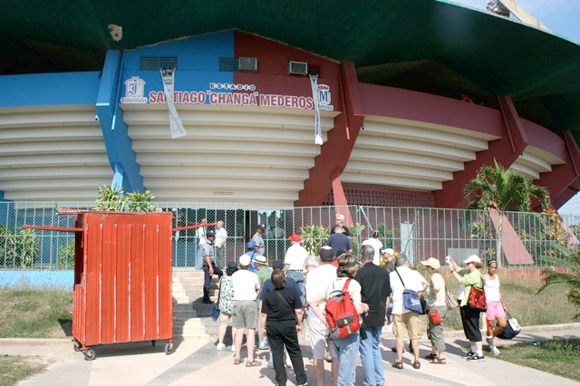
One good feature, from a photographer’s point of view: The entire grandstand is behind a tall chain link fence, which hampers photography, but in key spots just past first and third, the chain link has been cut and pulled away, clearing the way for cameras. Raise a glass to the unknown guerrilla photographers….

The style of play in Cuba is very entertaining. There were several great fielding plays and stolen bases, and a close play at home where the Metros runner was called safe, probably incorrectly. While the visiting team, Villa Clara, was up, their pitcher and a few players argued with the umpire from the dugout and were warned. When they went back out on the field, the large Villa Clara pitcher kept arguing with the ump until his manager pulled him. Walking back to the dugout, he kept yelling and gesturing to the local fans, until the manager came out and yanked him into the dugout. The fans had a great time.
Estadio Capitan San Luis (Pinar del Rio)
Pinar del Rio is Cuba’s western-most province, very lush and rural, and also the location for many of the largest Russian nuclear missile sites during the Cuban Missile Crisis of 1962. We arrived just as the game started and met several former players in the field-level seats right behind home plate. It started raining hard at the end of the first, the game was halted after two, and because of poor drainage, the dirt infield turned into a lake, causing the game to be called.

This turned into a great experience. Because they waited about an hour to call the game, many of the fans who stuck around, especially kids were very interested in talking with North Americans, and many of our group were fluent enough in Spanish to have conversations. We also came with caps, balls and especially baseball cards to give away, so it was a great experience even though the game got washed out.

Built in 1969, Estadio Capitan San Luis holds 8,000 and includes field level seats behind home plate. Spectators actually sit below field level, with their eyes about a foot above the field, for a great perspective of the pitcher and batter. All the other seating in the park are at least 10 feet above field level. Like some Cuban ballparks, most of the “seating” consists of benches, with no seats except for the first few rows and the field-level seats. The sizable press box sits at the back of the seats behind home, only about 12 rows from the field. We saw no concessions in the park, but they may have stayed away due to the rain.

Access to players was again evident at this park — we had the chance to talk with pitcher Pedro Luis Lazo, holder of the Cuban record of 257 wins (the Cuban season is 90 games). Lazo was the closer for Cuba in the first two World Baseball Classics.
Estadio Pedro Marrero/Tropical (Havana)
Built in 1929 and once considered the best ballpark in Cuba, La Tropical has 28,000 seats and was the main park for Cuban and Negro League baseball from 1930 to 1946, as well as the Cuban Winter League, which featured the likes of Satchel Page and Josh Gibson. It is now used for soccer and track and field.

As we walked around the grandstand during our brief visit, we met members of the Cuban Olympic track team working out.
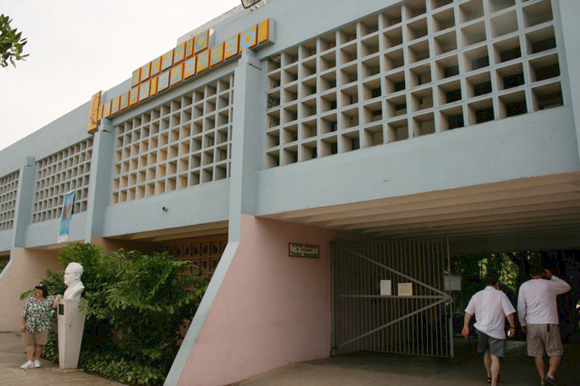
In another delightful and unexpected moment, we also happened upon a local high-school big band on the stage behind the grandstand, rehearsing several Count Basie numbers. They were fabulous. Where else can you tour an historic ballpark while watching an Olympic team practice to the sounds of Count Basie?
Estadio Cinqo de Septiembre (Cienfuegos)
This is one of the larger ballparks we visited, with a capacity of about 30,000. Like many of the Cuban parks, it is shaped a little like old Comiskey Park, with large bleachers heading diagonally out to center, with a large scoreboard in the middle. And, as in most parks, the seating is all benches, except for a few rows of individual seats in the infield.

A roof covers all the seats, but for a day game, the shade covers the infield seats, and about half of the outfield seats were in the sun. We arrived in the 6th inning of the first game of a make-up doubleheader. It was very hot, and the large crowd was crammed, standing room only, into the shaded areas, and nobody wanted to sit in the sun.

We were in a standing area behind home, but the area was gated, so nobody could move (which is why all my photos appear to be taken from one spot!). We were surprised when the second game was immediately cancelled and everyone was ordered to leave.
Estadio Jose Antonio Huelga (Sancti Spiritus)
Our visit here was for a night game on a cool evening. Night games are great in Cuba, because it’s cooler, people are off from work and are out for a good time. Best of all, this was a well-played game, with plenty of action, controversial plays and arguments over umpire calls, topped off by a walk-off home run.

The park holds about 12,000 fans. Although it looks larger from the outside, there are no outfield seats. There was a lot of activity outside the park, with by far the most variety of concessions. We also had the chance to meet the League Commissioner.

Like other parks, the section behind home plate features ground-level field boxes, about 13 rows of bench seats, and a press box that held about 20 people.

Since this was a rare night game, we were able to check out something new to me at a ballpark — the foul poles feature full-length florescent lights. We were not able to come to a conclusion as to whether the lights make it easier for the umps to rule a ball fair or foul, and we wondered if these have been tried in any U.S. minor-league park.
Estadio N.Guyen Van-Troi (Guantanamo)
This game and this ballpark really showed how exciting Cuban baseball can be — a night game, completely packed with 25,000+ fans, for a game against a western rival, Habana. A great band playing a style of hypnotic Cuban jazz had everyone dancing and waving large Cuban flags. The entire upper deck was lined with police and other security officers to maintain order, but this did not seem to limit the fans’ excitement. There were several vendors offering sandwiches and snacks, inside and outside the park.
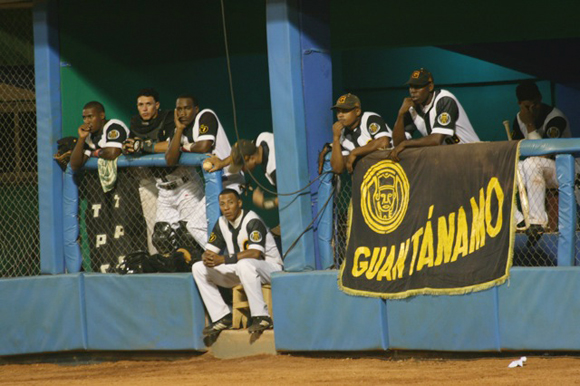
Like some other parks, the Guantanamo ballpark has an enclosed box seat area between the dugouts, right behind home. This area, while protected by chain link fencing, provides a great view of the field and good camera access), especially for plays at the plate, and there were several, including the tying run. To top it off, Guantanamo came from behind and won on a bases-loaded walk-off walk.
Estadio Guillermon Moncada (Santiago de Cuba)
Santiago de Cuba is the oldest and second largest city in Cuba (pop. almost 500,000), founded by the Spanish in 1514. It is also the location of Moncada Barracks, where Castro began his movement to overthrow the Batista regime in 1953. Estadio Guillermon Moncadaseats about 25,000.

Like some other Cuban ballparks, an interesting feature is three rows of box seats under the grandstand, at field level, that run from the dugouts to the foul poles. These seats have the benefit of a close view of the infield, as well as a guarantee of shade. Since Santiago is a major ballpark, there was a good selection of sandwiches and snacks, with vendors walking throughout the park.

After the game we encountered a busy market of game hats and jerseys for sale from both teams, including a game-worn World Baseball Classic BP jersey.
Estadio Julio Antonio Mella (Las Tunas)
The ballpark in Las Tunas (home of Los Cocodrilos) is typical of the smaller parks in rural cities in Cuba. Most of the seating is cement, and the grandstands appear to have been built at different times. The first-base and right-field stands are continuous out to center field, but look older than the two separate grandstands on the third-base line. All the stands have a partial roof, providing some shade, depending on the sun.

A colorful feature is the pair of large figures of Cuban National Team players, one on each side of the center field scoreboard. On the center-field wall, two large baseballs are painted with retired players’ names and numbers. The park has a few food concessions, and there are some small stands outside as well.
We came home with a wonderful experience of Cuba and Cuban baseball, which will always be in our thoughts when attending games in the US. We love our great new, comfortable ballparks (majors and minors), large food selection and cold microbrews, but games in Cuba seem to present a baseball experience focused completely on the game. Admission to the games is free, and people of all ages gather for the purpose of watching the games and rooting for their team. Despite the scarcity of food and drinks, souvenirs, entertainment and, in some parks, decent rest rooms, these parks were all packed with people watching the baseball game and rooting for their team. Just a great baseball experience.
—-
Share your news with the baseball community. Send it to us at editors@augustpublications.com.
Subscribers to the weekly Ballpark Digest newsletter see features before they’re posted to the site. You can sign up for a free subscription at the Newsletter Signup Page.
Join Ballpark Digest on Facebook and on Twitter!
